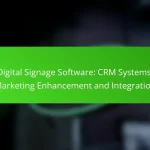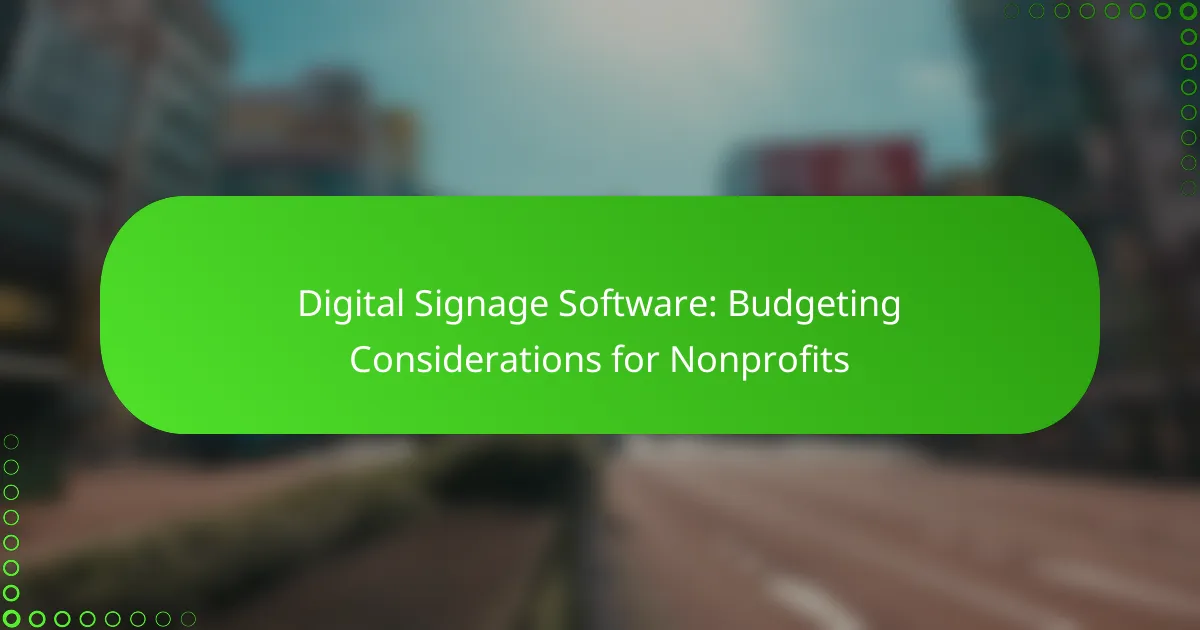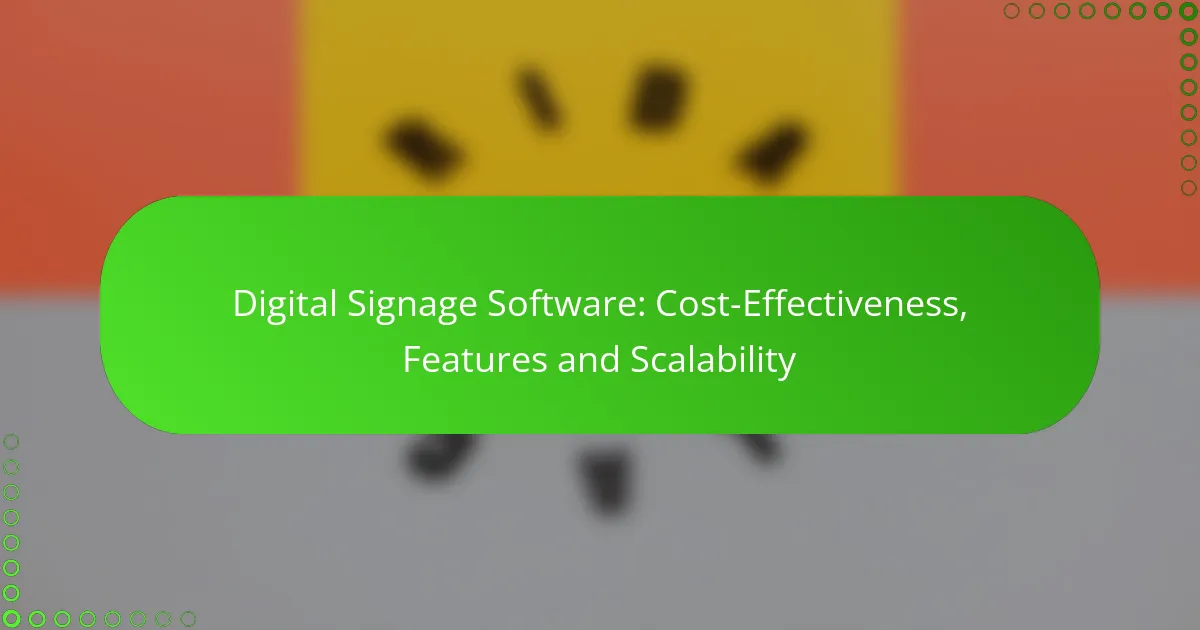For nonprofits in India, budgeting for digital signage software requires careful consideration of financial constraints and specific organizational needs. It is essential to explore cost-effective solutions, potential funding sources, and the implications of choosing between free and paid options. Additionally, understanding hidden costs such as maintenance and training can help ensure that the chosen software aligns with the nonprofit’s mission and enhances communication efforts.

What are the budgeting solutions for digital signage software in Indian nonprofits?
Indian nonprofits can explore various budgeting solutions for digital signage software that align with their financial constraints. Key considerations include selecting cost-effective options, identifying potential funding sources, and understanding the differences between free and paid software solutions.
Cost-effective software options
Cost-effective digital signage software options are crucial for nonprofits operating on limited budgets. Many providers offer tiered pricing models that cater to different organizational sizes and needs. Look for software that provides essential features without unnecessary extras, typically ranging from INR 5,000 to INR 20,000 annually.
Consider platforms that offer flexible payment plans or discounts for nonprofits, which can significantly reduce overall costs. Comparing features and pricing across several providers can help identify the best fit for your organization.
Funding sources for nonprofits
Nonprofits can tap into various funding sources to support their digital signage initiatives. Grants from government bodies, private foundations, and corporate sponsorships are common avenues. Research local and national grant opportunities that specifically fund technology improvements for nonprofits.
Additionally, consider crowdfunding campaigns or community fundraising events to raise money for digital signage projects. Engaging your community can not only provide financial support but also increase awareness of your mission.
Free and open-source software
Free and open-source digital signage software can be a viable option for nonprofits looking to minimize expenses. These solutions often provide robust features without the associated costs of proprietary software. Examples include Xibo and Screenly, which allow for customization and flexibility.
While using free software can save money, it may require more technical expertise for setup and maintenance. Ensure you have the necessary skills in-house or consider training volunteers to manage the software effectively.
Subscription vs. one-time purchase
When budgeting for digital signage software, nonprofits must weigh the pros and cons of subscription versus one-time purchase models. Subscription services typically offer ongoing support and updates, which can be beneficial for organizations that prefer a hands-off approach.
On the other hand, a one-time purchase may seem more economical upfront but could lead to higher long-term costs if updates and support are needed. Assess your organization’s capacity for ongoing expenses versus a larger initial investment to determine the best approach for your budget.

How to choose the right digital signage software?
Choosing the right digital signage software involves evaluating your nonprofit’s specific needs, budget, and the features that will best support your mission. Consider factors such as ease of use, scalability, and the ability to integrate with existing systems to ensure effective communication and engagement.
Key features for nonprofits
Nonprofits should prioritize features that enhance communication and outreach. Essential functionalities include content management systems, scheduling capabilities, and support for various media formats. Additionally, look for software that offers templates tailored for nonprofit messaging, allowing for quick updates and easy customization.
Consider tools that facilitate remote management, enabling staff to update displays from different locations. This is particularly useful for organizations with multiple sites or those hosting events in various venues.
Scalability considerations
Scalability is crucial for nonprofits that anticipate growth or changes in their outreach strategies. Choose software that can easily expand with your organization, whether that means adding more screens or increasing the complexity of your content. Look for solutions that offer tiered pricing plans, which can accommodate your budget as you grow.
Evaluate whether the software can integrate with other platforms you may adopt in the future. This ensures that as your needs evolve, your digital signage system can adapt without requiring a complete overhaul.
User-friendly interfaces
A user-friendly interface is vital for ensuring that all staff members can effectively use the digital signage software without extensive training. Look for intuitive dashboards that simplify content creation and scheduling. Features like drag-and-drop functionality can significantly reduce the learning curve.
Testing the software with a trial version can provide insight into its usability. Gather feedback from various team members to ensure that the interface meets the diverse skill levels within your organization.
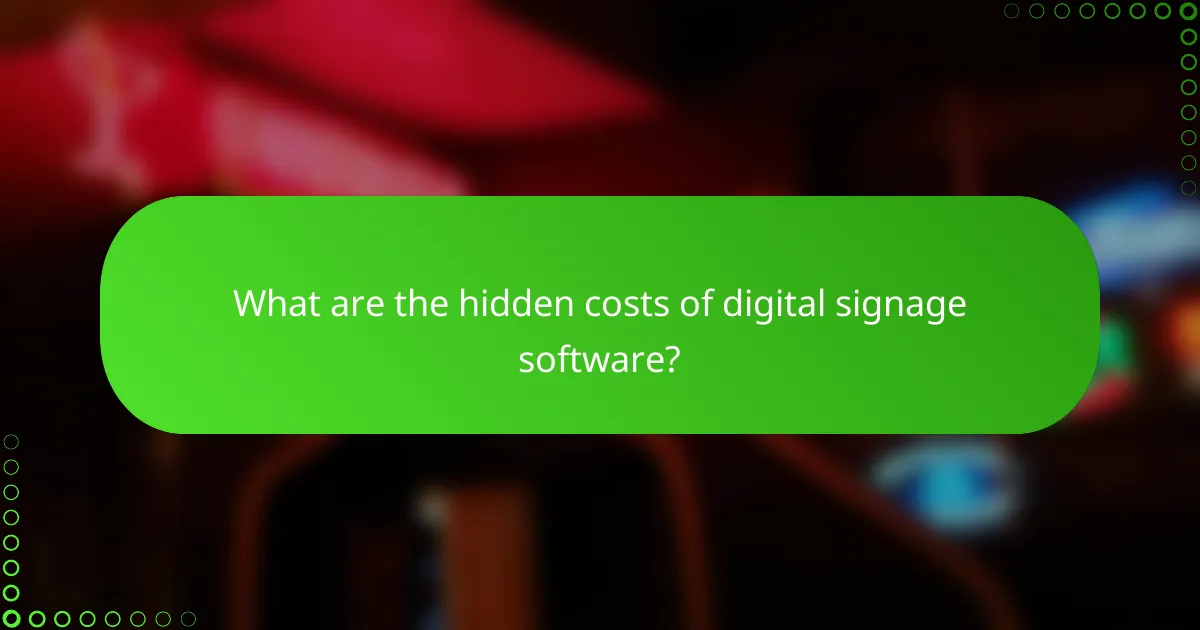
What are the hidden costs of digital signage software?
Hidden costs of digital signage software can significantly impact a nonprofit’s budget. Beyond the initial purchase price, organizations should consider ongoing expenses such as maintenance, training, and hardware requirements.
Maintenance and support fees
Maintenance and support fees are essential to keep digital signage software running smoothly. These costs can vary widely, often ranging from a few hundred to several thousand dollars annually, depending on the complexity of the system and the level of support required.
Nonprofits should evaluate whether the software provider includes basic support in the initial purchase or if ongoing fees are necessary. It’s advisable to budget for these costs to avoid unexpected financial strain.
Training costs for staff
Training costs for staff can be a significant hidden expense when implementing digital signage software. Depending on the software’s complexity, training sessions may range from a few hours to several days, costing hundreds to thousands of dollars.
Consider utilizing online training resources or vendor-provided training programs to minimize costs. Additionally, investing in a few key staff members to become proficient can help disseminate knowledge throughout the organization.
Hardware requirements
Hardware requirements are another hidden cost that nonprofits must factor in when budgeting for digital signage. This includes displays, media players, and mounting equipment, which can collectively cost anywhere from a few hundred to several thousand dollars.
It’s crucial to assess the specific needs of your organization and choose hardware that balances quality and affordability. Consider purchasing refurbished equipment or exploring grants that may help cover these costs.

What are the best practices for budgeting digital signage in India?
To effectively budget for digital signage in India, nonprofits should focus on understanding both initial costs and ongoing expenses. This includes hardware, software, content creation, and maintenance, ensuring that all aspects are accounted for to maximize impact.
Creating a detailed budget plan
A detailed budget plan is essential for managing digital signage costs. Start by listing all potential expenses, including hardware (like displays and media players), software subscriptions, installation fees, and content creation costs. Aim for a budget that covers both upfront investments and recurring expenses.
Consider using a spreadsheet to track these costs over time. This allows for easy adjustments as needs change or unexpected expenses arise. A well-structured plan can help prevent overspending and ensure funds are allocated appropriately.
Prioritizing essential features
When budgeting for digital signage, prioritize essential features that align with your nonprofit’s goals. Identify which functionalities are crucial, such as remote management, content scheduling, or analytics capabilities. This focus helps in making informed decisions about where to invest.
For instance, if real-time updates are vital for your organization, ensure that your budget accommodates software that supports this feature. Avoid spending on unnecessary add-ons that do not contribute directly to your mission.
Monitoring ongoing expenses
Regularly monitoring ongoing expenses is key to maintaining a sustainable digital signage budget. Track costs related to software renewals, content updates, and hardware maintenance to avoid surprises. Set aside a portion of your budget for unexpected repairs or upgrades.
Establish a review process, perhaps quarterly, to assess spending against your budget. This helps identify trends and allows for adjustments, ensuring that your digital signage remains effective without straining financial resources.
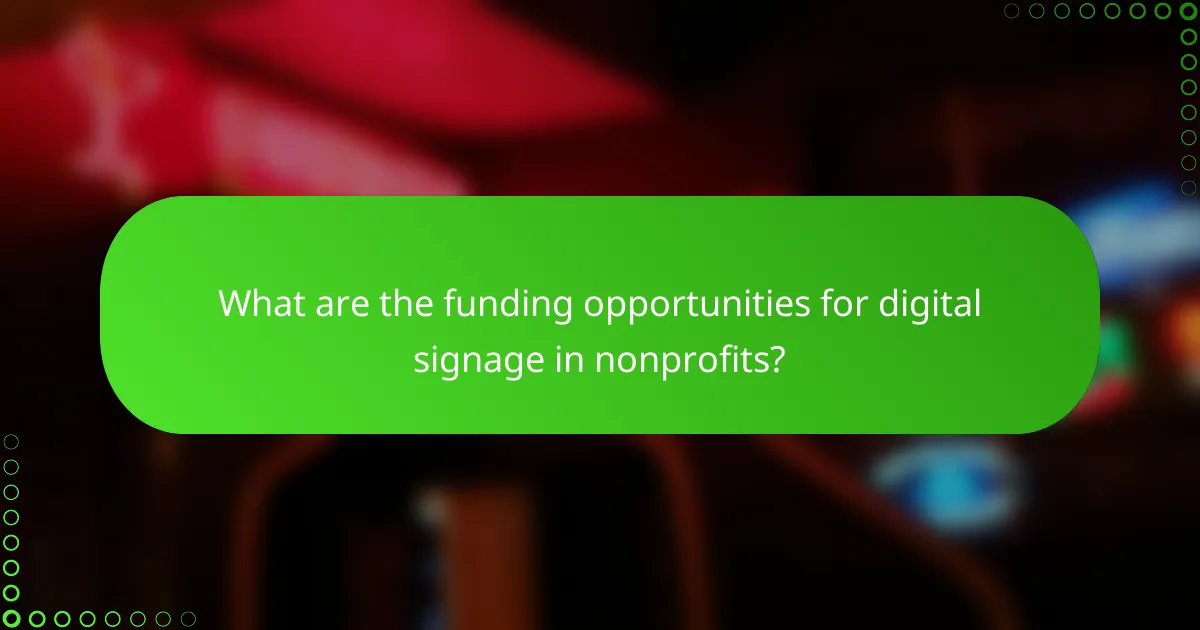
What are the funding opportunities for digital signage in nonprofits?
Nonprofits can explore various funding opportunities for digital signage, including grants, partnerships, and community support. These options can significantly reduce costs and enhance the effectiveness of digital communication efforts.
Grants for technology upgrades
Many foundations and government agencies offer grants specifically aimed at technology upgrades for nonprofits. These grants can cover a portion or all of the costs associated with purchasing and implementing digital signage systems.
When applying for grants, focus on demonstrating how digital signage will enhance your mission and outreach. Research local and national grant opportunities, and ensure your proposal aligns with the funder’s objectives.
Partnerships with local businesses
Forming partnerships with local businesses can provide valuable resources for funding digital signage initiatives. Businesses may be willing to sponsor signage in exchange for advertising space or recognition in your nonprofit’s materials.
To establish successful partnerships, identify businesses that align with your mission and values. Approach them with a clear proposal outlining mutual benefits, and consider offering promotional opportunities in return for their support.

How can nonprofits measure the ROI of digital signage?
Nonprofits can measure the ROI of digital signage by analyzing engagement metrics and assessing community impact. These two approaches provide insights into how effectively digital signage contributes to organizational goals and community outreach.
Tracking engagement metrics
Tracking engagement metrics involves monitoring how audiences interact with digital signage content. Key metrics include viewer counts, dwell time, and interaction rates, which can often be collected through software analytics or integrated sensors.
For example, a nonprofit might find that a specific campaign displayed on digital signage increases foot traffic to events by 20%. Regularly reviewing these metrics helps organizations adjust their content strategy to maximize viewer engagement.
Assessing community impact
Assessing community impact focuses on the broader effects of digital signage on the target audience and community. This can include measuring changes in community awareness, participation in programs, and overall sentiment towards the nonprofit.
Surveys and feedback forms can be effective tools for gathering qualitative data on how digital signage influences community perceptions. For instance, if a nonprofit notices a rise in volunteer sign-ups following a digital campaign, this indicates a positive community impact worth quantifying.

